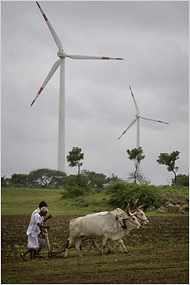For at least the past two election cycles, Americans have heard that new jobs could easily be created through development of green technologies, including sources of renewable energy. There hasn’t been much data to back up that claim, however, until now. A recent study shows that establishing a wind farm can create up to 1,100 new green jobs in the immediate area where it’s located, largely proving the correlation between a move to green energy sources and an improvement in the country’s overall economic position.
Plenty of Benefits for Communities with a Wind Farm
According to the National Resources Defense Council, establishment of a wind farm in any given community will result in the creation of 1,079 jobs on average. That accounts for an initial 522 jobs in construction, and 557 jobs in non-construction industries. The jobs span the gamut from construction-based jobs in electrical engineering, turbine construction, and building construction, to non-construction jobs in manufacturing, sales and distribution, and the employer of record department.
The benefits to communities where a wind farm is located don’t stop at the boon to local employment. While 1,100 new jobs is certainly nothing to write off, most communities experience a pretty big wave of revitalization during the facility’s construction — and after it begins operation. That revitalization comes as part of new taxes related to the facility, as well as lease payments to those who own the land where the wind turbines are actually installed.
Simply put, a wind farm’s location can actually help entire towns or smaller communities walk back from the edge of the fiscal cliff, filling local coffers with increased taxes and padding the pockets of land owners with lease payments and other fees.
The Future of the Wind-Powered Energy Market Remains Uncertain
Despite the many benefits that wind farms bring to their surrounding communities, and despite the many benefits of working toward energy independence, construction of new wind-powered facilities is actually in jeopardy. That’s because, due to congressional gridlock, the Production Tax Credit might actually expire. That tax credit is good for a 2.2 cent per kilowatt-hour tax rebate; without it, many wind farm companies might have to scale back their spending. And, with less spending, the country will experience a dramatic drop in wind facility construction.
While the effects of the tax credit’s expiration might be most significantly felt next year, some negative effects are already hitting workers at well-established wind farm facilities. Many companies, facing the prospect of tighter budgets and less wiggle room in the operations, have decided to scale back their work force at a number of wind farm sites. Those lost jobs work to directly reverse the positive effects of wind farm creation, and it’s a sure indicator that the tax credit’s renewal is one of the keys to success for the industry at large.
Hope for Renewal of the Tax Credit — and of America’s Communities
Luckily, the Production Tax Credit’s looming expiration date hasn’t gone unnoticed by some lawmakers in Washington. Democratic legislators in the Senate are firmly in favor of renewing the tax credit, and several of them are working together to fight for its continuation into next year. It is perhaps no surprise that Colorado Senator Michael Bennet is leading the charge to renew the tax credit and bring even more renewable energy jobs to communities around the country.
Colorado, after all, has one of the most thriving wind farm industries. The state has even put into place a plan that calls for a full 30 percent of the state’s energy to come from renewable sources by 2020. The wind-powered energy industry has been a key way to inch closer to that benchmark, and Colorado residents would suffer from a contracting renewable energy industry.
Plenty of Promise Nationwide for Wind Farms
With or without the Production Tax Credit, wind-powered energy looks to stay central to America’s energy policy in the years to come. The combination of a drive toward energy independence, a plan for the reduction in unemployment, and a return of the manufacturing sector, look to keep wind — and other green energy.
Image Credit: …-Wink-… via Flicker Creative Commons




